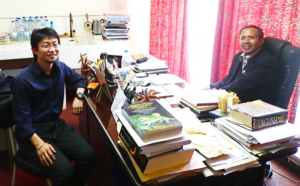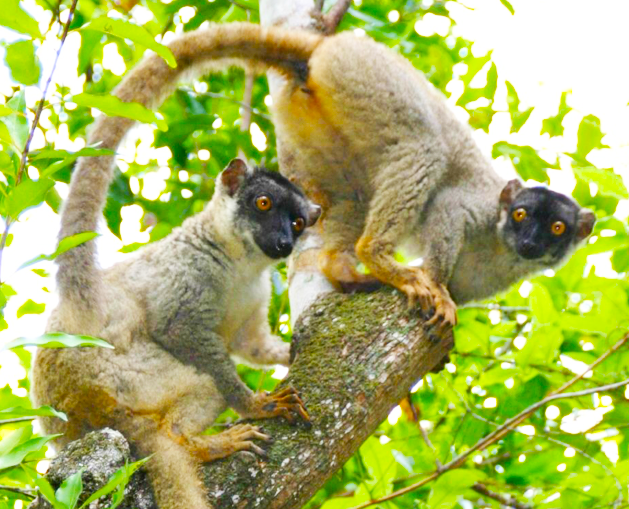
Brain circulation program trip report (Madagascar)
Hiroki Sato, Assistant Professor
Graduate School of Asian and African Area Studies (ASAFAS), Kyoto University
From February 13 to March 24, 2017, I travelled to the Republic of Madagascar for a research meeting and field survey.
1. Discussion on the academic exchange with the Faculty of Science, University of Antananarivo
On February 14, I arrived in Madagascar. On February 15, I visited Professor Hajanirina Rakotomanana and Associate Professor Felix Rakotondraparany at the Department of Zoology and Animal Biodiversity, Faculty of Science, University of Antananarivo for 2 days, to discuss the reorganization of the African Area Studies paradigm associated with globalization. On November 24, 2015, Professor Ikeno and Dr. Ichino of ASAFAS had a meeting with Dr. Rakotomanana and Dr. Rakotondraparany, and obtained consent to participate in future research. On my visit, I further discussed the academic exchange between ASAFAS and the Faculty of Science, University of Antananarivo with Dr. Rakotomanana and Dr. Rakotondraparany. Since I began fieldwork in Madagascar in 2005, ASAFAS has repeatedly conducted collaborative researches with them, consisting of short-term research projects with Grants-in-Aid for Scientific Research. However, there has been no official agreement regarding the academic exchange. Since the exchange of researchers between two research institutions has occurred through the brain circulation project, it was agreed that an official agreement on the academic exchange should be made in 2017. An early goal for ASAFAS is to accept international graduate students from the Faculty of Science, University of Antananarivo. Currently, Mr. Tojotanjona Razanaparany, who is a graduate student of Professor Rakotomanana and has been my co-researcher since 2015, is applying for a Japanese scholarship for international students. We confirmed that the academic exchange system will continue to be developed based on the present case, in which research instruction is provided jointly in field sites in Madagascar, nurturing young researchers from Japan and Madagascar through an exchange program.
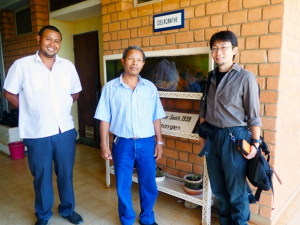 Photo 1. Mr. T. Razanaparany (left), Associate Professor F. Rakotondraparany (center), and the author (right) at the Faculty of Science, University of Antananarivo.
Photo 1. Mr. T. Razanaparany (left), Associate Professor F. Rakotondraparany (center), and the author (right) at the Faculty of Science, University of Antananarivo.
2.Field survey in Ankarafantsika National Park
On February 17, I traveled in a rented car to Ankarafantsika National Park, 400-km northwest of the capital Antananarivo to begin the field survey. My animal ecology survey has focused on the feeding ecology of the brown lemur (Eulemur fulvus). Through this, we discovered that lemurs eat fruit and disperse intact seeds through their droppings across the forest, contributing to the survival and growth of plants. The objective of the present survey as part of the brain circulation project was to reorganize the paradigm of the animal ecology study to an “Area Study”, and to find the potential contribution of this research to this region.
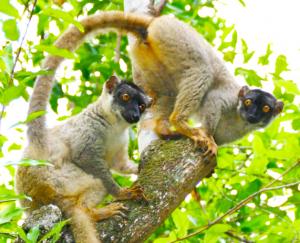 Photo 2. Brown lemur (Eulemur fulvus)
Photo 2. Brown lemur (Eulemur fulvus)
The first step is to expand this research from “animal ecology” to “plant ecology” that has been ongoing since 2014. There has been little research on how primates as seed dispersers contribute to the survival and growth of plants, and the regeneration of forests—from the perspective of plants—in Madagascar. I used several plant ecological methods to evaluate the survival and growth of seeds dispersed by brown lemurs. I confirmed the survival of seeds dispersed by brown lemurs in 2015.
Furthermore, I incorporated a “conservation biology” perspective, and surveyed the current conservation condition of the symbiotic system between primates and plants. Ankarafantsika National Park has been designated a conservation system according to the “Man and the Biosphere (MAB)” plan proposed by UNESCO. In other words, residents live inside the protected area, and the sustainable use of biological resources is permitted within the buffer zone. In contrast, in the core area, biological resources are strictly protected. However, in the present survey, forest fire, illegal logging, and poaching of lemurs for use as bushmeat, were confirmed within the Ankarafantsika National Park, where an idealistic plan has been realized; the contradiction between protection and use of biological resources was highlighted. The destruction of forest vegetation due to forest fire and logging leads directly to the destruction of habitat for wildlife, including lemurs. Furthermore, lemur poaching removes seed dispersers, potentially destroying the forest regeneration system that has uniquely evolved in Madagascar.
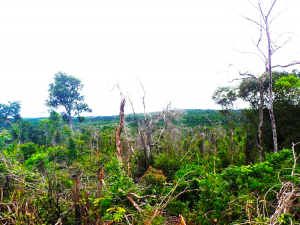 Photo 3. A site of forest fire occurred in 2014. The majority of tall trees were burned, and young pioneer trees are flourishing on the forest floor.
Photo 3. A site of forest fire occurred in 2014. The majority of tall trees were burned, and young pioneer trees are flourishing on the forest floor.
To learn the local knowledge, I began an ethnobotanical survey. We used interviews and participant observation to determine how residents in the Ankarafantsika National Park acknowledge and use forest plants. The results showed that biological resources are being used for building materials, tools, decorations, food, drugs, and sorcery, and that the existing knowledge may be related to scientific properties such as hardness of wood and medical effects. In addition, the seeds of many plants are dispersed by lemurs; therefore, seed dispersal by primates, which I have been studying, is closely related to the residents’ lives.
 Photo 4. A witch doctor (right) explaining the medical effects of a plant.
Photo 4. A witch doctor (right) explaining the medical effects of a plant.
From the present field survey, let us discuss how the region is being designed. Lemurs are popular worldwide as endangered species only endemic to Madagascar. In other words, lemurs are flagship animal species, and have been utilized to provide motivation for conservation management by the Madagascan government and foreign organizations. However, the value of these species has been forced on local residents by external entities in a top-down manner. It may be difficult for local residents to share the consciousness of nature conservation when only such terminology is forced upon them. Conversely, functions such as seed dispersal affect the overall ecosystem, and lemurs can be recognized as the keystone species in conservation activities. Furthermore, as indicated in the ethnobotanical survey, if local residents benefit from such a service of seed dispersal by lemurs, the value of a keystone species, rather than a flagship species, may be easier to understand regarding protection. Of course, we have reported the ecological values of lemurs throughout the scientific approaches. However, if we can summarize local knowledge and evaluate lemurs’ values as the keystone species along with the local residents, a bottom-up approach to environmental education and awareness innovation can occur. Although these visions still remain at an early stage, our survey has enabled us to reorganize the present study, which began as an animal ecology study, as an area study that designs the future of nature conservation areas, where protection and use are currently contradictory, and incorporates elements of plant ecology, conservation biology, and ethnobotany. We continued our survey in Ankarafantsika National Park until March 20, and drove back to Antananarivo on March 21.
3. Survey report and research meeting at the Faculty of Science, University of Antananarivo
On March 22–23, I revisited the Faculty of Science, University of Antananarivo, and reported the survey results to Professor Rakotomanana and Assistant Professor Rakotondraparany. We exchanged information on nature conservation activities and environmental education involving local residents, and the cases both faculties were involved in, along with the current conditions in Madagascar. Professor Rakotomanana described a project in which elementary school children across Madagascar were asked to observe and sketch birds, and an illustrated encyclopedia was created based on these sketches, accompanied by descriptions of each bird species by researchers. It was meaningful to hear from my co-researchers that such activities organized by local residents and students are effective methods of environmental education. Following the meeting at the University of Antananarivo, I left Madagascar from the Ivato airport on the afternoon of March 23, and arrived back in Japan on March 24, as planned.

